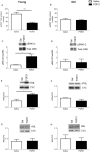Reduced adiposity attenuates FGF21 mediated metabolic improvements in the Siberian hamster
- PMID: 28652585
- PMCID: PMC5484705
- DOI: 10.1038/s41598-017-03607-x
Reduced adiposity attenuates FGF21 mediated metabolic improvements in the Siberian hamster
Abstract
FGF21 exerts profound metabolic effects in Siberian hamsters exposed to long day (LD) photoperiods that increase appetite and adiposity, however these effects are attenuated in short day (SD) animals that display hypophagia and reduced adiposity. The aim of this study was to investigate whether the beneficial effects of a novel mimetic of FGF21 in the LD state are a consequence of increased adiposity or of the central photoperiodic state. This was achieved by investigating effects of FGF21 in aged hamsters, which is associated with reduced adiposity. In LD hamsters with increased adiposity, FGF21 lowered body weight as a result of both reduced daily food intake and increased caloric expenditure, driven by an increase in whole-body fat oxidation. However, in LD animals with reduced adiposity, the effect of FGF21 on body weight, caloric intake and fat oxidation were significantly attenuated or absent when compared to those with increased adiposity. These attenuated/absent effects were underpinned by the inability of FGF21 to increase the expression of key thermogenic genes in interscapular and visceral WAT. Our study demonstrates the efficacy of a novel FGF21 mimetic in hamsters, but reveals attenuated effects in the animal model where adiposity is reduced naturally independent of photoperiod.
Conflict of interest statement
The authors declare that they have no competing interests.
Figures






Similar articles
-
Whole-body and adipose tissue-specific mechanisms underlying the metabolic effects of fibroblast growth factor 21 in the Siberian hamster.Mol Metab. 2020 Jan;31:45-54. doi: 10.1016/j.molmet.2019.10.009. Epub 2019 Nov 9. Mol Metab. 2020. PMID: 31918921 Free PMC article.
-
Increased responses to the actions of fibroblast growth factor 21 on energy balance and body weight in a seasonal model of adiposity.J Neuroendocrinol. 2013 Feb;25(2):180-9. doi: 10.1111/j.1365-2826.2012.02383.x. J Neuroendocrinol. 2013. PMID: 22958332
-
Photoperiodic regulation of FGF21 production in the Siberian hamster.Horm Behav. 2014 Jun;66(1):180-5. doi: 10.1016/j.yhbeh.2014.03.013. Horm Behav. 2014. PMID: 24909854
-
Photoperiodic control of seasonal body weight cycles in hamsters.Neurosci Biobehav Rev. 1985 Winter;9(4):599-612. doi: 10.1016/0149-7634(85)90006-5. Neurosci Biobehav Rev. 1985. PMID: 3909016 Review.
-
Leptin and seasonal mammals.J Neuroendocrinol. 2003 Apr;15(4):409-14. doi: 10.1046/j.1365-2826.2003.01007.x. J Neuroendocrinol. 2003. PMID: 12622842 Review.
Cited by
-
Photoperiodic changes in adiposity increase sensitivity of female Siberian hamsters to systemic VGF derived peptide TLQP-21.PLoS One. 2019 Aug 29;14(8):e0221517. doi: 10.1371/journal.pone.0221517. eCollection 2019. PLoS One. 2019. PMID: 31465472 Free PMC article.
-
Direct activation of the fibroblast growth factor-21 pathway in overweight and obese cats.Front Vet Sci. 2023 Jan 23;10:1072680. doi: 10.3389/fvets.2023.1072680. eCollection 2023. Front Vet Sci. 2023. PMID: 36756310 Free PMC article.
-
Activating Connexin43 gap junctions primes adipose tissue for therapeutic intervention.Acta Pharm Sin B. 2022 Jul;12(7):3063-3072. doi: 10.1016/j.apsb.2022.02.020. Epub 2022 Feb 26. Acta Pharm Sin B. 2022. PMID: 35865093 Free PMC article.
-
Whole-body and adipose tissue-specific mechanisms underlying the metabolic effects of fibroblast growth factor 21 in the Siberian hamster.Mol Metab. 2020 Jan;31:45-54. doi: 10.1016/j.molmet.2019.10.009. Epub 2019 Nov 9. Mol Metab. 2020. PMID: 31918921 Free PMC article.
-
Effects of Moderate Chronic Food Restriction on the Development of Postprandial Dyslipidemia with Ageing.Nutrients. 2019 Aug 10;11(8):1865. doi: 10.3390/nu11081865. Nutrients. 2019. PMID: 31405194 Free PMC article.
References
Publication types
MeSH terms
Substances
Grants and funding
LinkOut - more resources
Full Text Sources
Other Literature Sources
Medical
Research Materials

